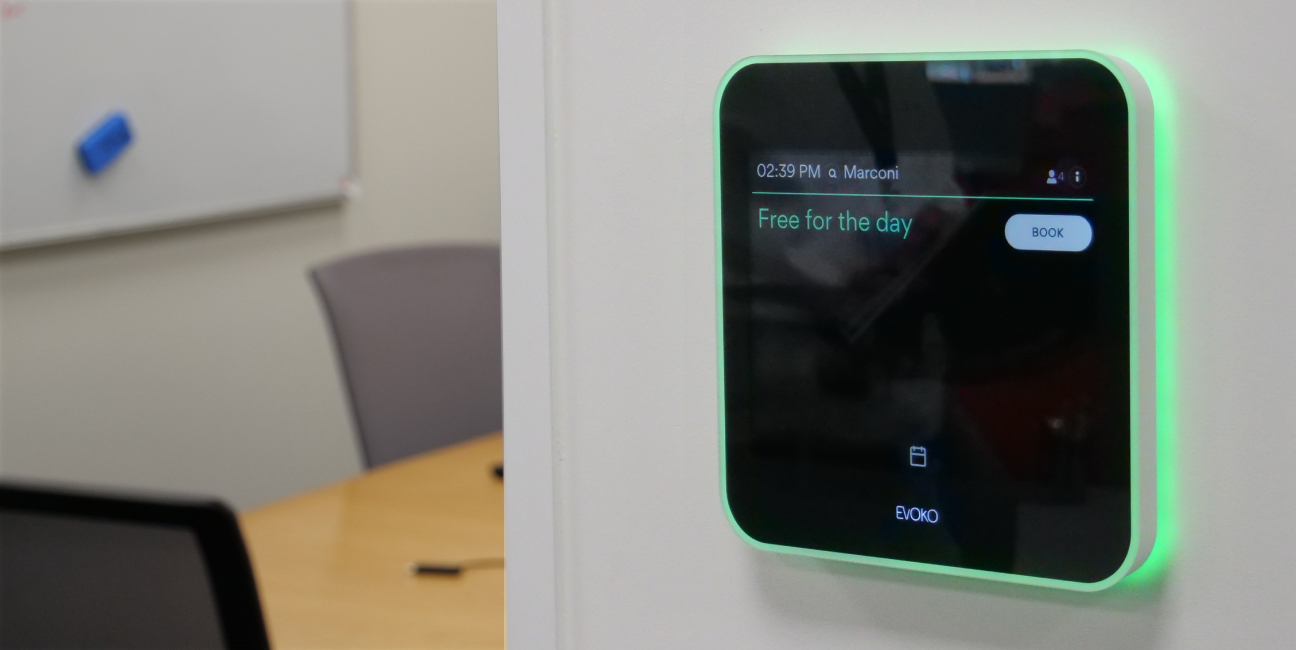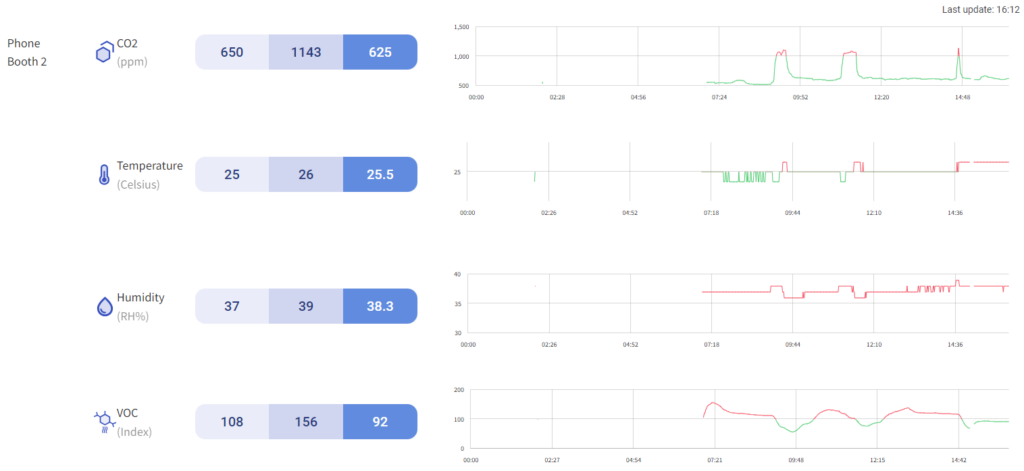

Are on-demand meeting rooms a productivity booster or a hindrance? In the modern era of workplace autonomy, their availability depends on an efficient meeting room management system. Outdated booking systems often result in conflicts, ‘ghost’ meetings, last-minute schedule changes, and unexplained room unavailability. Although modern systems offer improved control, merely granting employees the ability to book these spaces falls short of being a comprehensive solution.
In this blog, we delve into the ways organisations can cultivate a sophisticated meeting room system to efficiently manage availability, enforce policies, and monitor utilisation.

Challenges of traditional booking systems
Meeting rooms are intended to be the epicentre where ideas are shared, decisions are made, and strategies are developed. Traditional booking systems often prevent the optimal use of these vital spaces, and some of the everyday challenges employees grapple with include:
- Complex Reservation Process: This involves a convoluted process encompassing emails, calendars, and manual entry. These intricate steps result in inefficiencies and productivity loss, as evidenced by Atlassian’s findings of companies spending an additional $2,100 to $4,100 per year for excessive email communication costs.
- Out-of-sync Calendar: Calendars are often not in sync, leading to confusion, ghost meetings (instances where rooms remain unused despite reservations), double booking, and the additional challenge of unauthorised room usage.
- Room Overbooking and Underutilisation: Traditional setups don’t align well with the requirement of optimal room allocation, leading to issues like overbooked rooms and underutilised spaces.
- Wasted Time: Searching for empty meeting rooms equates to approximately 40% of the workforce wasting up to 30 minutes daily or 3.5 hours weekly, adding frustration and lost work hours.
- Lack of Integration and Analytics: Traditional booking systems often struggle to seamlessly integrate with other office management tools, hindering the ability to provide a cohesive user experience and collect valuable data for analytics.
These challenges persist in traditional meeting room booking systems and can hinder the efficient use of these vital spaces.
On-Demand solutions: reshaping meeting room bookings

With the rise of on-demand solutions, businesses now have access to more streamlined, efficient ways of managing room availability. These solutions alleviate common pain points and offer added benefits such as cost savings, increased productivity, and improved employee satisfaction.
Desk booking software, like the Freespace employee app, in conjunction with calendar management apps such as Outlook or Google, are notable on-demand solutions. They’re convenient for employees, simplify room bookings and prevent scheduling conflicts.
However, other modern desk booking apps offer convenient on-demand solutions for employees, streamlining room reservations and minimising scheduling conflicts. These tools have their limitations when used in isolation, such as a lack of capability to adapt to changing schedules or priorities. Some employee apps only consider one factor in room availability, such as occupancy. This can lead to issues with room size, amenities not meeting the specific needs of a particular meeting, and unused rooms. Moreover, calendar management apps often don’t provide real-time updates on room availability, leading to confusion and double bookings, resulting in lost time and productivity.
To address these shortcomings, a more comprehensive approach is needed.
Comprehending on-demand meeting room availability
The availability of meeting rooms on-demand embodies a dynamic and integrated system that provides real-time updates on room availability and booking changes. It seamlessly syncs with multiple platforms and is enhanced by digital signage, improving visibility.
However, achieving this level of autonomy requires more than just desk booking software and calendar integrations. It requires a holistic solution that combines advanced sensor technology, data analytics, user-friendly interfaces, and integrated policies to effectively govern all tools and systems.
Key features include:
- Real-time availability: Employees can instantly see which rooms are free, eliminating the frustration of double bookings and conflicting schedules
- Seamless calendar integration: On-demand solutions seamlessly integrate with existing calendar systems, ensuring that booked meetings align with individual and team schedules effortlessly
- User-friendly interfaces: This makes booking a meeting room as simple as a few clicks or taps, eliminating the need for convoluted processes
- Remote access: In our increasingly remote and hybrid work environment, these systems offer remote access to meeting room bookings, empowering employees to secure spaces whether they’re in the office or working from home
- Continuous feedback: On-demand systems thrive on feedback loops. By collecting and analysing user input, these solutions keep improving the booking experience, ensuring it aligns with the ever-evolving needs of the organisation
- Usage monitoring: Gensler states that 83% of corporate real estate executives rank space utilisation as the key metric for making workplace decisions. On-demand solutions go beyond booking and provide insights into how meeting rooms are being used making them impactful. This data allows organisations to optimise room allocation and make informed decisions
- Optimising room efficiency: On-demand solutions allow organisations to analyse occupancy data and identify rooms that are used but not to their full potential. For example, if a room with a capacity for 10 people consistently accommodates only 3-4 individuals, organisations can make informed decisions. This could involve splitting the room into two smaller spaces or implementing policies to encourage more efficient room usage
The in-control advantage
Staying in control of meeting room scheduling is pivotal to mastering on-demand availability.
The “In-Control Advantage,” a three-pronged strategy, transforms meeting room management by integrating room policies, automating the booking system, and setting rules to curb undesirable behaviours. Adoption of this strategy optimises organisational efficiency, reduces scheduling conflicts, and fosters responsible use.
Here’s how this three-pronged strategy can revolutionise your meeting room management:
- Setting room policies: Organisations establish clear policies for meeting room usage. This includes defining booking lead times, no-show periods, and rules for using meeting rooms effectively using an employee app
- Automation to reduce conflicts: Occupancy sensors continuously update room status in real-time, enabling automated actions to free up rooms in the calendar when they are unoccupied, even if previously booked. This proactive approach optimises room allocation and minimises scheduling conflicts
- Combatting undesirable behaviours: By monitoring how meeting rooms are used, organisations can identify undesirable behaviours. For instance: Are meetings regularly extended or moved on more than one occasion? Are certain individuals consistently booking meetings but not attending or using the room? To address these issues, some organisations implement a “three-strikes, you’re out” policy, reinforcing the importance of responsible room booking based on occupancy and actual use
- Air quality monitoring and control: Utilising air quality data, organisations can establish proactive policies to maintain a safe and comfortable meeting environment. When air quality metrics, such as CO2 levels or VOC fluctuations, reach predetermined thresholds sensors like PAM provide actionable data to external systems. Organisations can then restrict room booking until air quality improves or take immediate action to ventilate the space
- Flexible yet planned spaces: Policies are designed to strike a balance between flexibility and occupancy planning. This involves ensuring that enough flexible, ad-hoc spaces are available alongside planned/bookable rooms. A percentage of meeting rooms may be designated as non-bookable, solely based on “walk-in” usage. These rooms can be easily identified through signage, room type settings, or the booking calendar. For example, meeting rooms that seat six or fewer people may be categorised as non-bookable, allowing employees to walk in and use these spaces for smaller meetings
Right Size, Design, and Experience
All the above-mentioned facets (like real-time data, usage analytics, and the power of re-designing meeting spaces for optimal utilisation along with setting proper workplace policies) come together to create a harmonious, efficient meeting room ecosystem. It’s not just about design but rather about facilitating an environment where control and ease coexist. With Freespace, we offer an all-encompassing solution for meeting room management.

The concept of ‘right-sizing’ and ‘right designing’ hinges on designing meeting rooms that align with actual usage patterns. It’s about finding the sweet spot between room capacity and usage. TIM analytics (graph 1) provides a clear picture of how often and how efficiently space is being used. It empowers organisations to make informed decisions regarding room dimensions, ensuring that they are neither too large nor too small.

Similarly, it’s essential to assess the environmental factors that influence room comfort. Graph 2 shows data on how the duration of meetings impacts the room’s environment, which includes PAM sensor metrics like CO2, temperature, humidity, and VOC fluctuations. These insights shed light on how room conditions change over time, allowing organisations to create meeting spaces that provide a comfortable and productive experience for employees.

In addition to these features, the Freespace Employee App further enhances your control and convenience. Seamlessly integrated with calendar management solutions, this app empowers employees to book meeting rooms, view real-time availability, and make reservations effortlessly. By combining the capabilities of the EE App with our sensor technology, we’ve created a well-integrated solution that provides the control and ease you need.
Thus, Freespace offers a solution that ensures easy bookings, policy adherence, seamless integration, and in-depth usage analytics. This adaptable platform caters to organisations of all sizes, promoting accountability, punctuality, and a well-structured meeting room experience. So why settle for chaos when you can have control, comfort, and convenience all in one package?
Get in touch with us today to experience the full potential of on-demand meeting room availability.


